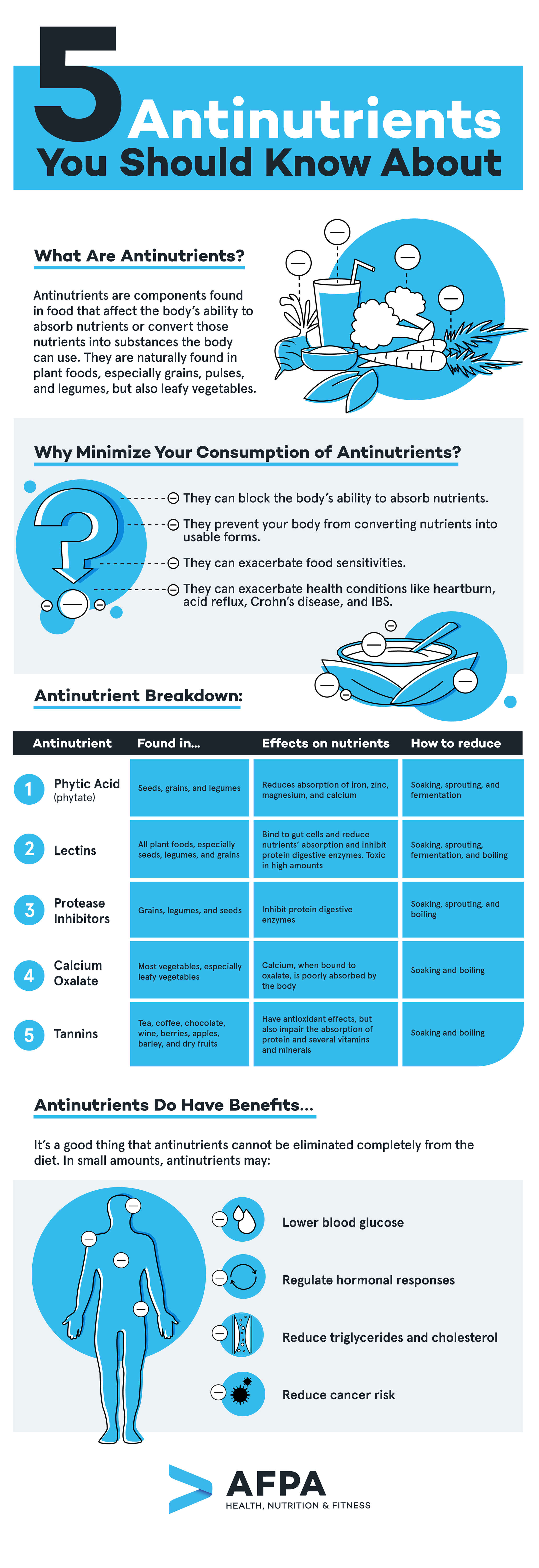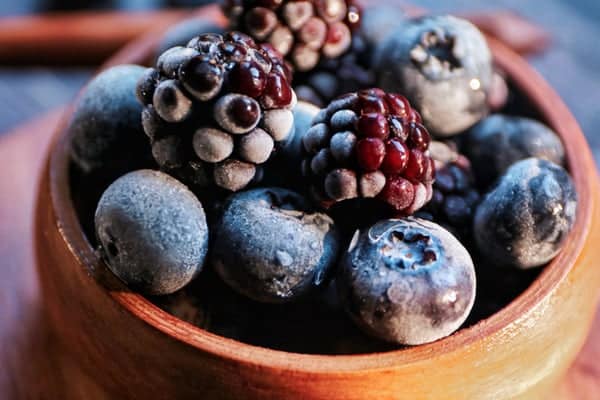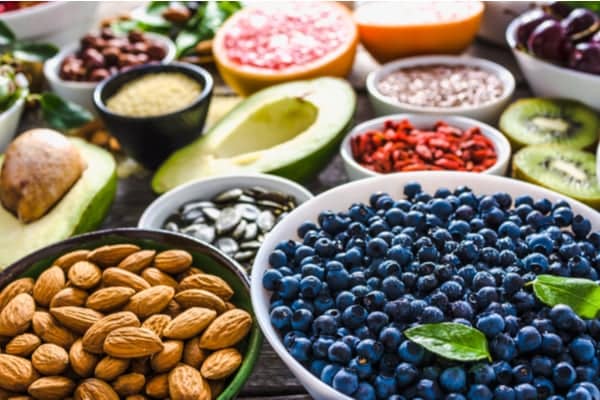Nutrients are the components found in food and beverages that have important functions in the body. You’ve heard of the main categories of nutrients—carbohydrates, fats, proteins, vitamins, and minerals—but have you heard of antinutrients?
The names of antinutrients are a bit more of a mouthful—lectins, phytate, calcium oxalate, and tannins.
If you eat a diet rich in whole grains and legumes, especially if you follow a plant-based diet, it is important you know about antinutrients in your food and how to minimize them.
In contrast to nutrients, they are generally associated with negative effects on your nutritional status.
Why are antinutrients unpopular? They may be affecting your body’s ability to absorb and utilize essential nutrients from your diet. In small quantities, however, they have antioxidant and anticarcinogenic potential.
Here is an overview of some of the most common antinutrients, their effects on your health, and how to reduce them in your foods.

Get Your Free Guide to Becoming a Holistic Nutritionist
Learn about the important role of holistic nutritionists, what it takes to be successful as one, and how to build a lucrative, impactful career in nutrition.

What Are Antinutrients?
Antinutrients are components found in food that affect the body’s ability to absorb nutrients or convert those nutrients into substances the body can use. They are naturally found in plant foods, especially grains, pulses, and legumes, but also leafy vegetables.
5 Common Antinutrients in Food
Phytic acid (phytate)
Phytic acid is found in grains, seeds, pulses, and legumes. They block the absorption of important dietary minerals like iron, zinc, magnesium, and calcium.
Lectins
Lectins are commonly found in legumes, fruits, salad ingredients, and whole grains and can interfere with the absorption of minerals like calcium, zinc, iron, and phosphorus. In high amounts, they can be toxic and lead to malnutrition.
Protease inhibitors
Protease inhibitors are found in numerous plant foods, but in high amounts in seeds, grains, pulses, and legumes. They interfere with the digestive enzymes that break down proteins into usable amino acids. Due to protease inhibitors, some of the protein found in plant foods isn’t readily absorbed unless it undergoes cooking, soaking, or fermentation.
Calcium oxalate
Calcium oxalate is the main form of calcium in green leafy vegetables. However, when calcium is bound to oxalate, it is poorly absorbed by the human body, meaning that we cannot make use of most of the calcium in raw plant foods.
Tannins
Tannins are a type of flavonoid antioxidant found in dark-colored fruits, wine, coffee, tea, and chocolate. While the health-enhancing properties of tannin-containing foods are nearly unquestionable, tannins impair the absorption of protein and several vitamins and minerals.
How to Reduce Antinutrients in Food
Soaking
Most of the antinutrients in pulses, like peas, and legumes, like beans, lentils, and chickpeas, are found in the skin. These antinutrients are water-soluble, meaning that they dissolve when they are exposed to water.
By soaking them overnight and discarding the water they were soaked in, you can reduce the presence of different phytates by up to 9%, lectins by up to 50%, tannins by up to 25%, and protease inhibitors by up to 30%.
Sprouting
By sprouting your grains, legumes, and pulses, you can help increase the availability of nutrients the food provides. Research shows that sprouting cereals can help to increase protein availability and digestibility, lower the glycemic index of foods, and increase mineral availability.
You can sprout your grains and legumes by soaking them and then placing them in a place to sprout in the shade while rinsing them twice a day for 2-3 days. Sprouting can slightly reduce lectin and protease inhibitors and has the potential to reduce some phytates by up to 80%.
Fermenting
Fermentation is a process by which bacteria and yeasts start to digest the carbohydrates in food. It is also a method that has been used for thousands of years for preserving food.
Coffee and cocoa are fermented when they are being prepared for consumption, and the antinutrients are reduced in the process.
Sourdough is a great example of the use of fermentation to improve nutrient availability. Sourdough fermentation is more effective at increasing grain nutrient availability than yeast fermentation. The natural fermentation process reduces the antinutrients that bind to dietary minerals in the bread to make them more readily available for use by the human body.
Some foods that can be readily eaten after a fermentation process that degrades the antinutrients in foods include sourdough bread, beans, and soy.
Boiling
Boiling is a quick way to reduce some types of antinutrients, and it is can reduce some antinutrients by up to 80%. Lectins, tannins, protease inhibitors, and calcium oxalate are heat-sensitive, so they are reduced in foods when boiled. Phytates, however, are not heat-sensitive, so boiling isn’t an effective way to reduce phytates in foods.
Keep in mind that exposing foods to boiling water can also reduce their nutrient content. Heat-sensitive nutrients, like vitamin C and B vitamins, leach out of the leafy greens into the water when boiled.
Some Antinutrients Are Allies to Your Health
It might make you nervous to know that the cooking and preparation methods mentioned above only partially eliminate antinutrients in food. However, certain phytonutrients in small amounts have health benefits as well.
Tannins, for example, are well-known for their antioxidant and anticarcinogenic properties. They are one of the reasons why foods like dark purple fruits, wine, and dark chocolate are considered “superfoods.”
Phytates have also been shown to have some health benefits. They can help to lower cholesterol, regulate blood glucose, reduce the formation of kidney stones, and slow digestion.
Protease inhibitors in the forms of drugs and plant medicines are also currently being explored for use in cancer therapy and even COVID-19 treatment.
You Eat a Plant-Based Diet: Should You Worry about Antinutrients?
The short answer: In most cases, no. Researchers from all backgrounds have established the benefits of a plant-based diet for reducing the risk and treating chronic diseases. For people without nutrient deficiencies, the presence of antinutrients aren’t a reason to reduce the consumption of plant foods.
Additionally, research shows that people following plant-based diets rich in foods with antinutrients aren’t deficient in zinc or iron, which are some of the most susceptible minerals to absorption blockage by antinutrients. This suggests that people following plant-based diets may be adapting to the presence of antinutrients.
Also, keep in mind that many of the foods that are high in antinutrients, namely grains and legumes, undergo soaking and boiling for them to be suitable for consumption anyway. Leafy greens also tend to be soaked in water for disinfection, which also reduces antinutrients. These processes reduce the presence of antinutrients in foods, and you don’t need to do anything out of the norm.
The only population that should have special considerations for antinutrients are people at risk of nutrient deficiencies, like iron-deficiency anemia, or nutrient-related degenerative diseases, like osteoporosis. In these cases, people can work to choose foods lower in phytonutrients, soak, ferment, sprout, or boil them, and make sure to eat balanced and varied meals throughout the day.
For the most part, the risks of regularly eating foods high in antinutrients do not outweigh the benefits of a plant-based diet.

Become an Expert Nutrition Coach at Your Own Pace
Download your free guide now.



